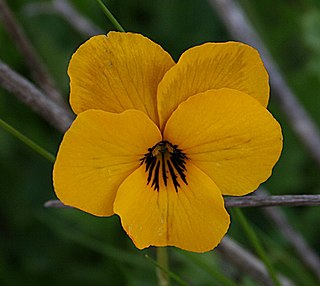
Viola pedunculata, the California golden violet, Johnny jump up, or yellow pansy, is a perennial yellow wildflower of the coast and coastal ranges in California and northwestern Baja California. The common name "Johnny jump up" is usually associated with Viola tricolor however, the introduced garden annual.

Dendromecon rigida, also called bush poppy or tree poppy, is a shrub or small tree of the Papaveraceae native to California and Baja California.

Prunella vulgaris, the common self-heal, heal-all, woundwort, heart-of-the-earth, carpenter's herb, brownwort or blue curls, is a herbaceous plant in the mint family Lamiaceae.

Asclepias fascicularis is a species of milkweed known by the common names narrowleaf milkweed and Mexican whorled milkweed. It is a perennial herb that grows in a variety of habitats.
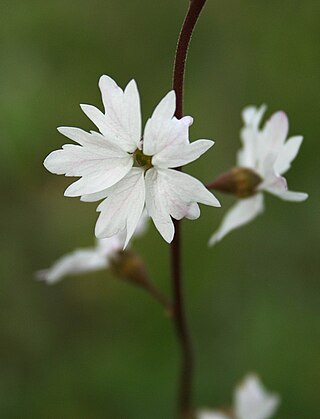
Lithophragma is a genus of flowering plants in the saxifrage family containing about nine species native to western North America. These plants are known generally as woodland stars. The petals of the flowers are usually bright white with deep, long lobes or teeth. Each petal may look like three to five petals, when at closer inspection the lobes fuse into a single petal at its base. Most species reproduce via bulblets instead of seeds. L. maximum is a federally listed endangered species. Lithophragma specifically coevolved with moths of the genus Greya, who pollinate and only lay eggs on Lithophragma plants.

Jepsonia malvifolia is an uncommon species of flowering plant in the saxifrage family known by the common name island jepsonia or island button-saxifrage. It is found only on the Channel Islands of California and Guadalupe Island off Baja California. It grows in exposed rock and clay soils on the chaparral and scrub slopes of the islands. This is a small perennial herb growing up to 10 inches tall. It produces two or three leaves from a flat caudex. The green leaves are round or kidney-shaped and edged with ruffled lobes. The plant flowers in fall, producing an inflorescence on a tall peduncle. The tiny flowers have red-veined white, yellowish, or pinkish petals. The fruit is a tan-striped greenish capsule. Its chromosome number is 2n=14.

Arctostaphylos luciana is a species of manzanita known by the common name Santa Lucia manzanita, is endemic to California.

Calandrinia breweri is a species of flowering plant in the family Montiaceae known by the common name Brewer's redmaids.

Calochortus elegans is a species of flowering plant in the lily family known by the common name elegant Mariposa lily, cat's ear, elegant cat's ears or star tulip. It is native to the western United States from northern California to Montana.
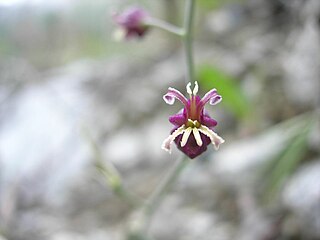
Caulanthus amplexicaulis is a species of flowering plant in the family Brassicaceae known by the common name claspingleaf wild cabbage.

Caulanthus glaucus is a species of flowering plant in the family Brassicaceae known by the common names glaucous wild cabbage, bigleaf wildcabbage, and limestone jewelflower.

Clarkia tembloriensis is a rare species of flowering plant in the evening primrose family, known by the common name Temblor Range clarkia and belonging to the Onagraceae family.
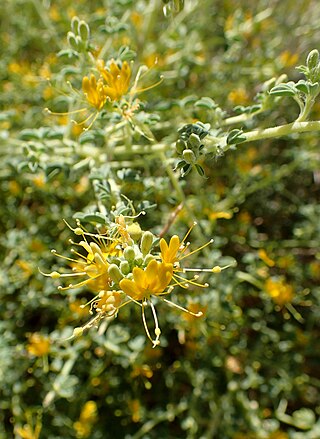
Cleomella obtusifolia is a species of flowering plant in the cleome family. It is commonly known as Mojave stinkweed, bluntleaf stinkweed or Mojave Cleomella. It grows in alkaline soils in the desert scrub. It is an annual herb producing a rough, hairy stem. The branching stem grows erect when new and then the branches droop to the ground with age, forming a bushy clump or mat. Each leaf is made up of three fleshy oval leaflets. Flowers appear in dense racemes on older stems and solitary in leaf axils on new stems. Each flower has generally four hairy green sepals and four yellow petals grouped together on one side of the involucre. The whiskery yellow stamens protrude up to 1.5 centimeters from the flower. The fruit is a hairy, valved capsule a few millimeters in length. It hangs at the tip of the remaining flower receptacle.
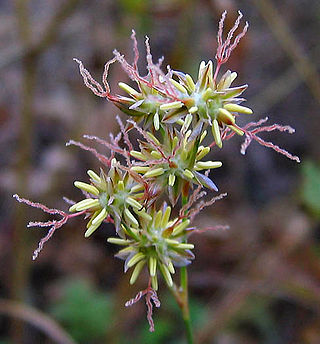
Juncus macrophyllus is a species of rush known by the common name longleaf rush.

Lithophragma parviflorum is a species of flowering plant in the saxifrage family known by the common name smallflower woodland star. It is native to much of western North America from British Columbia to California to South Dakota and Nebraska, where it grows in several types of open habitat. It is a rhizomatous perennial herb growing erect or leaning with a naked flowering stem. The leaves are mainly located low on the stem, each cut into three lobes or divided into three lobed leaflets. The stem bears up to 14 flowers, each in a cuplike calyx of red or green sepals. The five petals are bright white, up to 1.6 centimeters long, and usually divided into three toothlike lobes.
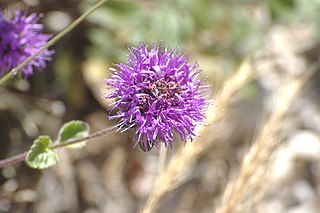
Monardella undulata subsp. undulata, synonym Monardella frutescens, is a rare subspecies of flowering plant in the mint family known by the common name San Luis Obispo monardella.
Potentilla rimicola is a species of cinquefoil-Potentilla, known by the common name cliff cinquefoil.

Sagittaria sanfordii is an uncommon species of flowering plant in the water plantain family known by the common names valley arrowhead and Sanford's arrowhead that is endemic to California.
Boechera tularensis, common name Tulare rockcress, is a plant species endemic to California. It has been reported from Inyo, Mono, Tulare, Fresno, Madera, El Dorado and Mariposa Counties. It grows on rocky slopes in subalpine habitats at elevations of 2400–3200 m.

Thingia is a monospecific genus of flowering plant in the family Montiaceae comprised only by the species Thingia ambigua, known as desert pussypaws. It is native to northwestern Mexico, California, and Arizona, and is found commonly on sandy or silty soil. The sole species of the genus has been housed under several genera before it was split into Thingia: Claytonia in 1882, Calandrinia in 1893, and Cistanthe in 1990. DNA evidence demonstrated that the relationship of Thingia ambigua, then Cistanthe ambigua, to the next closest relative in Cistanthe, C. tweedyi, was actually disjointed. It was found that the two species were most closely related to completely separate South American taxa.



















